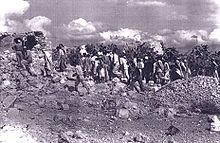
Back مذبحة قبيا Arabic Kibíjský masakr Czech Qibya-Massaker German Masacre de Qibya Spanish کشتار قبیه Persian Qibyan verilöyly Finnish Massacre de Qibya French פעולת קיביה HE Kivjái mészárlás Hungarian Pembantaian Qibya ID
| Operation Shoshana | |
|---|---|
| Part of the Palestinian Fedayeen insurgency and the Israeli reprisal operations | |
 Palestinian villagers returning to the village of Qibya after the Israeli massacre | |
| Location | Qibya, West Bank |
| Coordinates | 31°58′39″N 35°00′35″E / 31.97750°N 35.00972°E |
| Date | October 14, 1953 |
| Target | Palestinian Arabs |
Attack type | Mortar and dynamite attack |
| Deaths | 69 Palestinian civilians |
| Perpetrators | |
| Motive | Retaliation for the Yehud attack cited as motive by the Israeli government |
The Qibya massacre occurred during Operation Shoshana, an Israeli so-called reprisal operation that occurred in October 1953, when IDF's Unit 101 led by future Israeli Prime Minister Ariel Sharon attacked the village of Qibya in the West Bank, which was then under Jordanian control, and killed more than sixty-nine Palestinian civilians, two-thirds of whom were women and children.[1][2]
Forty-five houses, a school, and a mosque were destroyed.[3] Ariel Sharon wrote in his diary that "Qibya was to be an example for everyone," and that he ordered "maximal killing and damage to property". Post-operational reports speak of breaking into houses and clearing them with grenades and shooting.[4]
The attack followed cross-border raids from the West Bank. Israel framed the Qibya massacre as a response to the Yehud attack, in which an Israeli woman and her two children were killed.[1][5]
The massacre was condemned by the U.S. State Department, the UN Security Council, and by Jewish communities worldwide.[6] The State Department described the raid as "shocking" and used the occasion to confirm publicly that economic aid to Israel had been suspended previously, for other non-compliance regarding the 1949 Armistice Agreements.
- ^ a b Ganin, Zvi (2005), An Uneasy Relationship: American Jewish Leadership And Israel, 1948–1957, Syracuse University Press, p. 191, ISBN 9780815630517
- ^ Shlaim, Avi (1999). The Iron Wall. Norton. p. 91. ISBN 0-393-04816-0.
- ^ Benny Morris, Israel's Border Wars, 1949–1956: Arab Infiltration, Israeli Retaliation and the Countdown to the Suez War, Oxford University Press, 1993, pp. 258–9.
- ^ Cite error: The named reference
Bm1was invoked but never defined (see the help page). - ^ Byman, Daniel (2011). A High Price: The Triumphs and Failures of Israeli Counterterrorism. Oxford University Press. p. 22. Retrieved 14 October 2014.
- ^ Avi Shlaim (2001). The Iron Wall: Israel and the Arab World. W. W. Norton & Company. p. 91. ISBN 0-393-32112-6.
The Qibya massacre unleashed against Israel a storm of international protest of unprecedented severity in the country's short history.
